Janakpur
The city of Janakpur, 135 kilometers (84 miles) southeast of Kathmandu is doubly famous as the birthplace of the Hindu goddess Sita, as well as being the site where she was married to Lord Rama.

According to the Hindu epic, the Ramayana, the original city of Janakpur was named after King Janak of the Mithila kingdom. Janak found the baby Sita in a furrow of a field and raised her as his daughter. When Sita (also called Janaki) was about sixteen, the king announced that she could be married by whoever was able to string the divine bow of Shiva. Though many royal suitors tried, only Lord Rama, the prince of Ayodhya, was successful. And not only did he string the bow, he also snapped it in two. Thus, Lord Rama won the hand of Sita.
Historical sources indicate that the Mithila Kingdom controlled a large part of northern India between the tenth and third centuries BC when it came under the control of the Mauryan Empire (321 to 185 BC). The two great Mauryan emperors, Chandragupta and Ashoka, favored the religions of Jainism and Buddhism, and both the great saints Gautama Buddha, founder of Buddhism, and Vardamana Mahavira, the 24th and final Tirthankara (an enlightened sage) of the Jain religion, are said to have lived in Mithila/Janakpur. Following the decline of the Mauryan Empire, Janakpur languished as a religious site for two millennia until the seventeenth century.
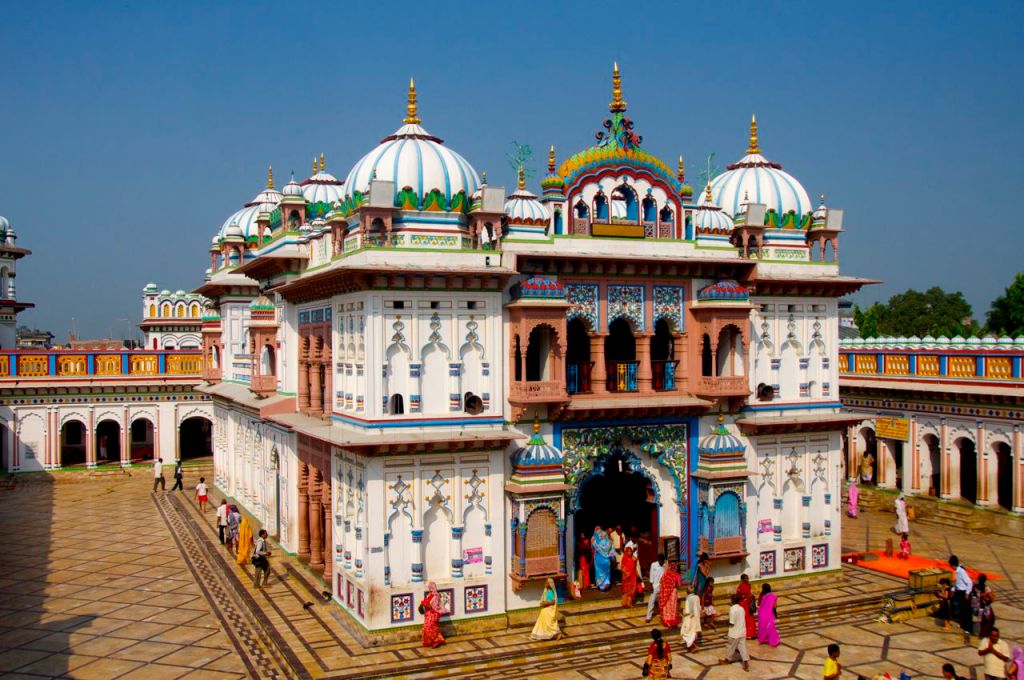
In 1657, the great saint and poet Sannyasi Shurkishordas discovered a golden statue of the Goddess Sita at the exact place where she was born, which ultimately became the location of the current Janaki Mandir, the Temple of Sita. Shurkishordas is considered to be the founder of modern Janakpur.
Queen Brisabhanu Kunwari of Tikamgarh built the Janaki Mandir in 1911. The temple is architecturally unique in Nepal. Its inner sanctum contains a flower-bedecked statue of Sita that was apparently miraculously found in the Saryu River near Ayodhya. Statues of Rama and his half-brothers Lakshman, Bharat and Satrughna stand by Sita. Early evenings are the best times to visit, for then the temple is lit with colorful lights and filled with hundreds of pilgrims expressing devotion for Sita and Rama. The temple is particularly popular with women, who wear their best clothes when visiting the shrine. Adjacent to the Janaki Mandir is the Rama Sita Bibaha Mandir, a building that marks the place where Rama and Sita were married.
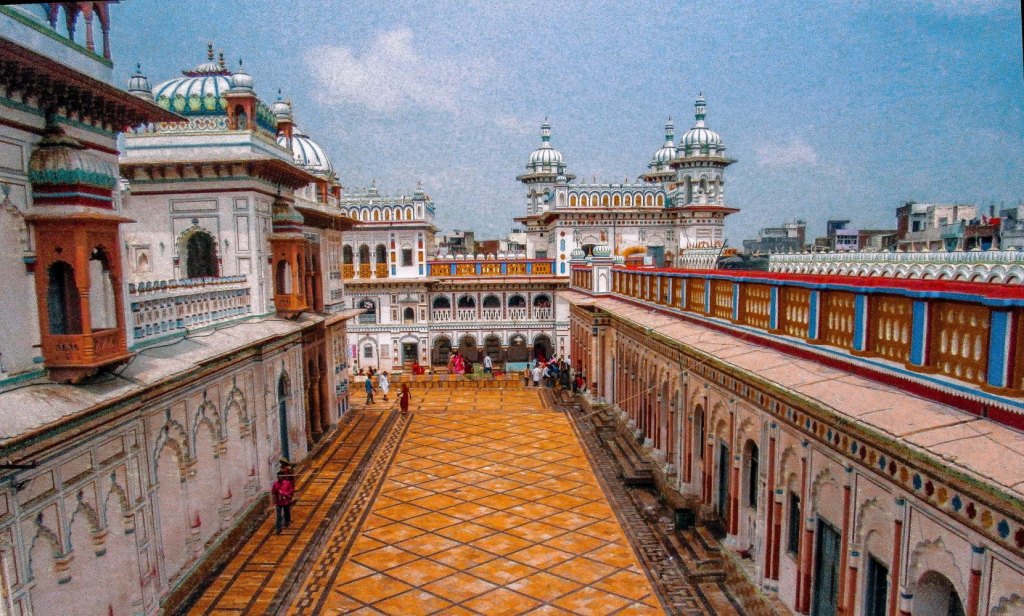
Tens of thousands of pilgrims visit Janakpur to pay homage to Sita at the time of Vivah Panchami, the marriage day of Sita and Ram (the fifth day of the Shukla Paksha or waxing phase of moon in November/December) and on Ram Navami, the birthday of Lord Rama (the ninth day of the Hindu month of Chaitra, which begins with the new moon in March/April).
Additional periods for large celebrations in Janakpur are Holi, the festival of colors in March; Diwali, the festival of lights in early November; and Chhath, a four-day festival celebrated by the local Mithila people in May and November.
Other important religious sites in the city include the Danush Sagar and Ganga Sagar ritual bathing tanks near the Janaki Mandir, and the winding streets surrounding the temple are filled with shops selling garlands of colorful flowers, pictures of various Hindu deities, and ritual objects for prayers.
Near Janakpur lies the ancient place of Dhanushadham, another important religious site for the Hindus. The Dhanusha pond is believed to have been made by the pieces of arrow broken by the Rama in Janakpur.
Places to visit in Janakpur
Janaki Mandir
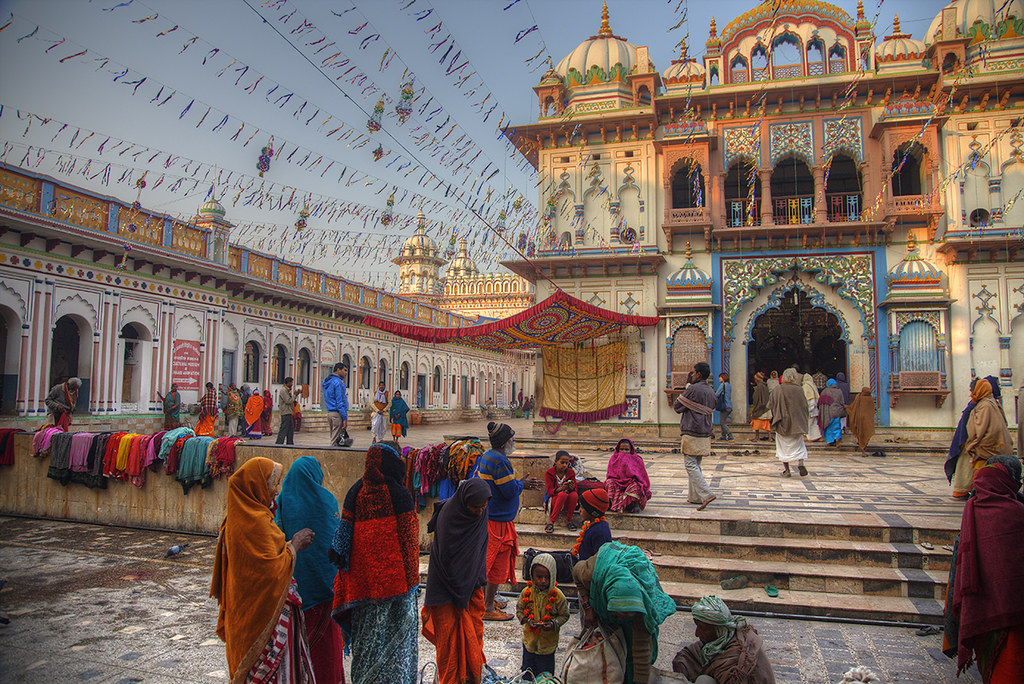
Dedicated to Goddess Sita, Janaki Mandir is the biggest temple in Nepal. The dominant tourist attraction of Janakpur is constructed at the place where Goddess Sita was born. The attraction is now considered as a religiously important monument and a heritage site but is still an active temple for devotees. Anybody seeking a slice of the legend of Ramayana must visit the divine Janaki Temple. The temple is predominantly thronged by devotees of the Goddess and her consort, Lord Rama, during auspicious occasions and festivals like the Ram Navami, Vivah Panchami, Dashain, Deepavali, and Holi. Pilgrims come in from all around Nepal, Sri Lanka and India to worship the Goddess who is deemed an epitome of courage, purity, selflessness, dedication, loyalty and feminine virtues.
Ram Mandir (temple):
The Ram Mandir is about a 10-minute walk from Janaki Mandir, right opposite Dhanusagar. At the right side of the temple are many stone idols of the Lord Shiva. The main festival celebrated in Ram mandir is Ram Navami (during April) and Vivah Panchami. As Ram Navami is the birth tithi (date) of Ram, so special bhajans are sung on the day. On Vivah Panchami, some special traditional codes are performed between Ram Mandir and Janaki Mandir as marriage codes to be followed. The nearby Rajdevi Temple is decorated during the Dashain festival. On the 8th day of Dashain, Mahastami, thousands of goats are offered to goddess Rajdevi. According to the visitors and locals, daytime is for worship, while nighttime is to revel in the temple’s beauty.
Dhanushadham:
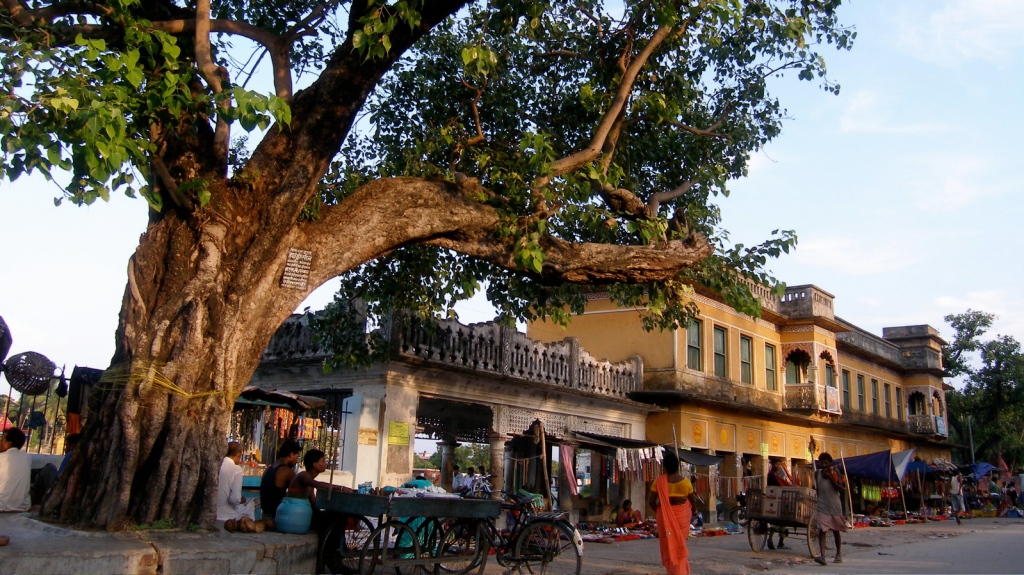
About 13 kilometres from Janakpur, Dhanushadham plays a prominent role in the Ramayana: According to the epic, when Ram broke the special bow to win Sita’s hand, pieces of the bow fell into Dhanushadham. On the route to Dhanushadham from Janakpur lies Parsuram Talau, another pond with religious history. In between the pond exists a nearly 20-foot-high high Shiva idol and a snake concrete structure.
Ram Sita Vivah Mandap
The place where Ram and Sita got married, Ram Janaki Vivah Mandap is visited by thousands of pilgrims to pay homage to Sita at the time of Vivah Panchami. The marriage day of Sita and Ram usually celebrated on the fifth day of the Shukla Paksha or waxing phase of moon in November/December. The mandap is a gorgeous structure made of marble located in the southwest region of the Janaki Mandir. It resembles a part of a palace with sturdy pillars, elegant arches and stunning domes.
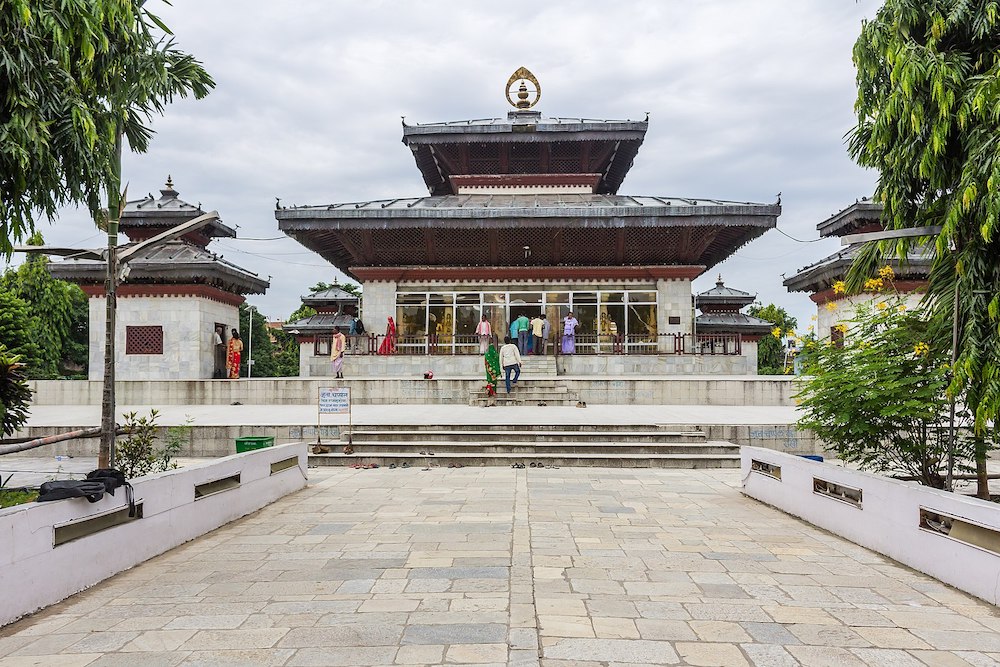
At the centre of the mandap, the legendary wedding ceremony is depicted. One can see idols of the couple, Goddess Sita and Lord Rama, sitting on a raised pedestal in the centre while some sages and their parents are seen seated on parallel pedestals facing each other. The idols are draped in colourful attires and give a sense of the ancient royal celebration. Devotees can offer their prayers and sit in complete silence to soak in the tranquil vibe of the temple. Those interested in getting a sneak peek into this epic union must visit the Ram Sita Vivah Mandap.
Jaleshwar
Jaleswar is a small municipality in Nepal, named after the holy temple of Jaleshwarnath Mahadev, dedicated to Lord Shiva. The small-town borders India with Bihar. During the months of Shravan that is July and August, devotees from all over the world flock here to pay their respects to the Lord and his Consort, Parvati. From historical sites and cultural attractions to parks and beaches, the city has something to offer to all its visitors.
Since Jaleshwar revolves only around the Jaleshwarnath Temple, the transport facilities withing the temple are also quite functional and comprehensive. Visiting the temple is a hassle-free experience as the buses also go to big cities like Kathmandu and Birgunj and connect to the main Janakpur city regularly. There are also many small eateries in the town and vegetarian restaurants are a majority in this little temple town.
Dhanush Sagar, Ganga Sagar and Parshuram Kunda

Janakpurdham is said to have as many as 115 ancient ponds of historical and mythological importance. Among the ponds, Ganga Sagar, Parshuram Kunda and Dhanusha Sagar are held extremely sacred. Dhanush Sagar and Ganga Sagar are two sacred ponds situated near the Ram Mandir. Here, people perform religious ablutions during the early morning hours. However, during the festivals, these ponds become extremely important in the sense that religious ceremonies conducted here. You can also find numerous cisterns all along the place. This also has religious connotations. In fact, these were built by King Janak who anticipated the arrival of Gods after the holy marriage of Rama and Sita. Likewise, Parshuram Kunda is said to be the pond where Maharishi Parshuram bathed to quell his anger after his confrontation with Ram over the breaking of the sacred bow of Shiva. It lies 4 km west of Dhanushadham. The pond is picturesque, with lotus flowers floating on it and lush trees on its southern banks.
Nari Bikas Kendra (Women Development Center):
The nonprofit center provides a safe and supportive space for women from the Janakpur area to develop their skills and earn independent livelihoods. The artists’ cooperative has resulted in many women going on to start their own business. The center teaches literacy skills and business training to women, as well as no-judgment support sessions in which women can debate their roles in family and society.
Initially specializing in paper art typical to the Mithila region, the center has since expanded into sewing, screen-printing, ceramics and painting.
Janakpur Dham Rail Station
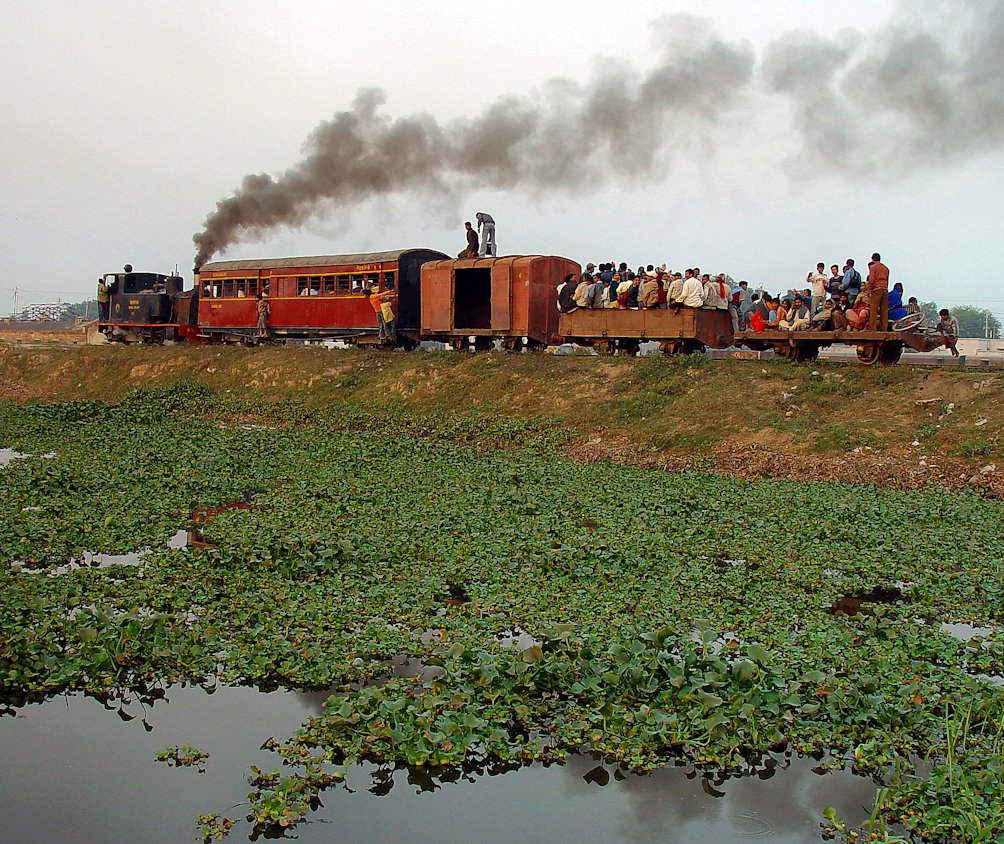
Don’t forget to make a short visit to Janakpur Dham Rail Station while spending your day at Janakpur. It is the first and only operational railway in Nepal making it a cool thing to do in Janakpur Nepal. Janakpur Dham Rail Station was built in 19th century by the British East India Company for the purpose of transporting goods such as timber and several other raw products.
Traditional Villages
During rooming around the temples of Janakpur, do not forget to make a short excursion into the village life of Janakpur. While strolling around the villages of Janakpur you can see traditional villages. The traditional villages in Janakpur showcase Mithili art and culture. Many of the villages are built in the traditional Mithila style, with mud walls decorated with colorful paintings of people and animals.
Cultural dances of Janakpurdham
Jata-Jatin
This dance is performed at night by a group of rural women in the month of Bhadra (August/September) when there is a drought. The women catch frogs and put them in small pitchers filled with a mixture of water and cow dung. The women divide themselves into two groups – one masquerading as the male, which is called ‘Jata’, and the other as the female and is called ‘Jatin’. The women then place the pitchers on their heads and go about the village, singing a song in question-answer form. At the end, they throw the pitchers into the courtyard of a person assumed to be evil-minded, and then disperse. The cultural dance is performed with the hope that there will be rain.
Jhijhiya
This festival (on the 6th day of the bright lunar fortnight in Kartik) is the most auspicious festival of Mithilanchal. (Another dance worth watching is performed by a group of women every year in the month of Ashwin (September/October) during the Dashain festival from Ghatasthapana to Vijaya Dashami.) In the Jhijhiya dance, some women place pitchers, with a burning lamp inside, on their heads. The pitcher has a large number of holes, and should anyone be able to count the exact number, it is believed that the vessel will catch fire, and the woman carrying it will die. The singing and dancing go on for hours, with groups of women taking turns to carry the pitchers.
Sama Chakeba
This is a play performed by the rural women of Mithilanchal for a fortnight, starting on Chhath in the month of Kartik (October/November) and lasting till the full moon. Through this play, women express their affection to their brothers. Every evening, women leave their homes with dolls in a bamboo basket, in the middle of which they place a burning lamp. They gather at a certain crossing and sit in a circle, singing till midnight. On the final night, they burn the moustache of ‘Chugla’, the evil doll. The dolls are then disposed off amidst the playing of such musical instruments as drums and the flute in the presence of their brothers.
Jharri
This play is performed at the time of ‘Hanuman- Jhand’ (celebration commemorating Lord Hanuman’s flag) and ‘Daha’ or ‘Tajiya’ (Muslim rituals). About 10-15 men perform this dance with a stick that is about 18 inches long. The singing and dancing go on for hours.
Lo Ka Sa Nkirtan (devotional songs)
The devotional songs teach us about morality and fraternity while creating awareness about human life. About 15 male singers sing the devotional Unique cultural dances of Janakpurdham 14 songs accompanied by such musical instruments as the harmonium, dholak (drum), gumti (onesided small drum), bastarang (musical instrument made of bamboo strips), jhals (cymbals) and other instruments.
There are four types of Loka Sankirtans:
a) General Loka Sankirtan – Sung in a group and accompanied by music.
b) Jhanki Loka Sankirtan – Devotional songs are sung to the deities that grace a platform. During the singing, offerings are made to the deities.
c) Bishaya Sankirtan – Team members follow the lead singer. The hymns could last hours.
d) Jhanki Vivah Sankirtan – It enacts the scenes of the wedding ceremony of Goddess Sita with Lord Ram. Despite the difficulties, the rural women of Mithilanchal have preserved this tradition that date from the Treta Yug. LEELAS (episodes from the lives of gods): Among such episodes staged, ‘Ram-Leela’, ‘Krishna- Leela’, ‘Ras-Leela’ and Shiva-Leela’ are very popular, but ‘Ram-Leela’ tops the list. It lasts upto a month, and during the period, the entire episodes of the Ramayan are presented on stage by group artists
Folk dances and dramas
Mithilanchal has been the centre of folk dances and dramas since the 5th century. It is said that in birth, life and death, music never abandons a person in Mithilanchal. Some of the ancient dances are the Badhaiya Nach, Pamariya Nach – both of which are performed within a month of birth – Chhaukarbaji Nach and Ras Nach. Among the folk dramas, the most ancient are Salhesh, Gopichan, Bharthari (Bratihari), Saranga-Sadabriksh, Mahasti Bihula, Bideshiya, Hirani-Birani, Dulara Dayal, Naika-Banijara and Domakacha. These folk dramas have been handed down through word of mouth. Besides these dramas, there are Nautankis (light dramas) which are heroic presentations. Among them are Amar Singh Rathour, Laila-Majnu and Shiri-Farhad. These Nautankis performed on stage are accompanied by music played on one big drum, three small drums along with the harmonium and other musical instruments.
Mithila paintings & folk art
Mithila paintings are renowned the world over. There is a painting centre at Kuwa, Janakpurdham, where nearly five dozen rural women from different villages are involved in preparing paintings of Mithila folk art for export to Western countries and other markets. You will find Mithila paintings on the mud walls of rural homes, which are done by housewives. These mud wall paintings are done using local lime, ochre (locally called geru), and brown and black soot collected from the bottom of pots and pans.
How to reach Janakpur
By Air
Fly into Kathmandu’s Tribhuwan International Airport, the only airport in Nepal for non-domestic flights. Once in Kathmandu, take a short domestic flight (about 25 minutes) to Janakpur Airport. Buddha Air offers twice-daily flights, and Yeti Airlines also has a daily flight to the city. Flying is by far the shortest way to get to Janakpur, and Nepalis and Indian citizens can avail of special prices.
By Bus
There are many ways to get to Janakpur via road, from various regions of Nepal and even the Indian border. You can take a microbus that leaves from Koteshwor in Kathmandu or even reserve a jeep. Usually, it takes around 7-8 hours from the BP highway, a picturesque highway named after the first democratically elected prime minister of Nepal. Microbuses leave every half hour from from 6 am to around 10:30 am.
Another option is to take a bus from Kalanki that goes from Kathmandu via Narayangarh. Night buses are also available from this route. It usually takes around 12-15 hours to reach from this route. There are also daily buses from Birgung, Biratnagar, and Kakarbhitta.
If you are coming from India, you can take a taxi from nearby cities next to the Nepal border. Remember that visas for Nepal are only waived for Indian nationals.
By Bike
Every year, Story Cycle and Sambridha Sindhuli organize a cycling event to promote Sindhuli and Janakpur. It attracts a lot of international crowd as over 150 cyclists from different parts of Nepal and abroad participate in the event. The ride will contribute towards preservation and promotion of the historical heritage fort Sindhuli Gadhi and the heritage city Janakpur by collating information, designing it, and disseminating to a wider audience in order to promote tourism and economic status of the locals
Ponds of Janakpurdham in Nepal
Ganga Sagar
Any pilgrimage is incomplete without a ritual bath in this pond which has never dried up. According to popular belief, water from the Seven Seas and all sacred places were collected, and this sacred pond called Ganga Sagar took shape.
Dhanush Sagar
This pond lies in front of Ram Mandir. It is said that the bow which Lord Shiva had given to King Janak during the Treta Yug was kept at this place for safe keeping, and the pond was built in the shape of the weapon.
ANGRAG SAR, locally called ARAGAJA
This pond lies north of Janaki Mandir. Goddess Janaki, or Sita, used to bathe in this pond after smearing her body with turmeric cream. It is said that a dip in the pond cures one of skin diseases.
Maharaj saga r (Das Harath Tatab)
This pond lies about 200 m to the west of Shree Janaki Mandir. Sage Parshuram is said to have been absolved of his sin of matricide after taking a dip in the pond. Later Lord Shiva, too, was pardoned for killing Parshuram after a ritual bath in this pond. The temple of King Dasharath, father of Lord Ram, lies on the west bank and the office of the Greater Janakpur Region Development Council on the north bank of this pond.
Ratna Sagar
This pond is to the northwest of Rangabhoomi and Ramananda Chowk. It is said that King Janak used to store jewels in this pond. People say that the bow turns a shining red when observed from one corner of the pond while it disappears after prayers and lighting of the ritual flame by the priests of the local temple.
Kapalmo Chan Sar
This pond lies to the northwest of Maharaj Sagar. According to legend, Lord Brahma found himself greatly attracted to his own daughter, Saraswati, Goddess of Learning, who then had to seek refuge with Lord Shiva for protection. Lord Shiva, in his Chhat festival 11 wrath, beheaded Brahma, but the head got stuck to his hand. It was only after Lord Shiva took a dip in this pond that the head of Brahma got detached.
Bihar Kunda
This pond lies to the southwest of Rangabhoomi and Ramananda Chowk. Even after her marriage to Lord Ram, Sita, with her sisters and friends, used to frequent the pond for a bath. The water of this pond is so clean that the people drink straight from it.
Agni Kunda
This pond lies about half a kilometre to the southwest of Ratna Sagar, where yagyas (offering made to a sacred fire) used to take place during Vedic times. Although comparatively small in size to other ponds, it is very deep.
Pad Prakshalan Sar
This pond lies to the south of Shree Janaki Mandir. King Janak and Queen Sunaina are said to have washed the feet of Lord Ram with water here at the time of the wedding. It was only later that a pond took shape.
Pap Mochar Sar
This pond is located at Pidari Chowk. A ritual bath in this pond absolves one of all sins.
BISHAHARA SAR
This pond lies to the east of the historical Tirhutiya Gacchi (Garden of Tirhut), once a large orchard of mangoes, rose apples, licchis and guavas in ancient times. A dip in this pond absolves one of all his sins.
Janak Sar
It was in this pond that King Janak took his baths.
Murali Sar
This pond is in the northeast direction of Vidyapati Chowk. Lord Krishna is said to have appeared thrice in Janakpurdham, where he played the flute (murali), hence the name Murali Sar.
Festival of Janakpur
As the birthplace of Goddess Sita and the kingdom of the great Hindu King Janak, Janakpur has always been a centre of attraction among pilgrims around the world. The area is equally known for its historic legacy of Mithila culture, customs and tradition.
Ram Navami
Ram Navami is a day celebrated in honor and memory of Lord Ram, who is believed to be the incarnation of Lord Vishnu. It is celebrated mostly fondly by Nepali people, visiting nearby temple of Lord Ram with flowers and other offerings. For Hindus, Lord Ram symbolizes “the ideal man”. His victory Ravan is seen as the manifestation of good over evil even in the most dire situations.
Ram or Vishnu temples all over Kathmandu valley and in different parts of Nepal are thronged with devotees on this day. Ram Mandir in Battisputali, Changu Narayan in Bhaktapur, and Budhanilkantha Temple, Ichangu Narayan and Bichangu Narayan in Kathmandu outskirts are filled with devotees on this day. The Ram Janaki Temple in Janakpur also hosts thousands of visitors on this day.
Chhath
Chhath parva is celebrated by natives of Mithila region of Nepal and India. This festival is dedicated to god Sun. Sun is called Surya in Sanscrit, Chhat parba is thanks giving to lord Surya for sustaining life on earth and to worship him to provide his continuous blessings to mankind.
The Sun, source power of nature, considered the god of energy and lord of the life-force, is worshiped in Chhath to promote well-being, prosperity and progress. Hindu people believe sun helps to cure many illness and diseases. Sun is considered as source of healing too. Sun is also considered as token of stability and prosperity. Therefore, people worship sun to ensure the longevity and prosperity of family members, friends and beloved ones.
Bivah Panchami
Bivah Panchami is celebrated to mark the marriage of Lord Ram and Sita as all the people of the Hindu world know the story of the marriage of the Ram and the princess Sita, as told in the epic Ramayana.
King Janak, Sita’s father, proposed a test of strength for the suitors of his daughter: to string the great bow of Lord Shiva. Warriors, kins and chieftains came from afar, but no man could even lift the bow. Ram lifted the bow with ease and when he tried to string it, the bow shattered into pieces.
Ram and Sita were married in Janakpur, now in southern Nepal, and their marriage is celebrated to this day. Each year, idols of Ram and Sita are brought out in procession and their Hindu wedding ceremony is re-enacted during a weeklong religious fair. Bibah Panchami reflects the devotion of Hindus to Ram, perhaps the most popular among the incarnations of Vishnu, and to Sita, the model of the ideal Hindu woman.
Holi
There is the tradition of celebrating Holi in Janakpur which is marked as a day after the conclusion of the 15-day Mithila Madhyamika Parikrama, a pilgrimage which takes the devotees on a journey covering 135 kilometers on foot. The Madhyamika Parikrama is considered the greatest religious ritual in Mithilanchal which is taken to be the cultural link and a symbol of friendship between Nepal and India. In Janakpur people enjoy playing Holi festival by throwing colored water to each other, painting each other face with different powder color, new dresses are bought to children, family members, relatives & friends gather together to enjoy the delicious food specially made on Holi festival named – Gujiya, rice pudding, sweets etc.. In the evening they enjoy with cultural dance, play cards, and so on.

